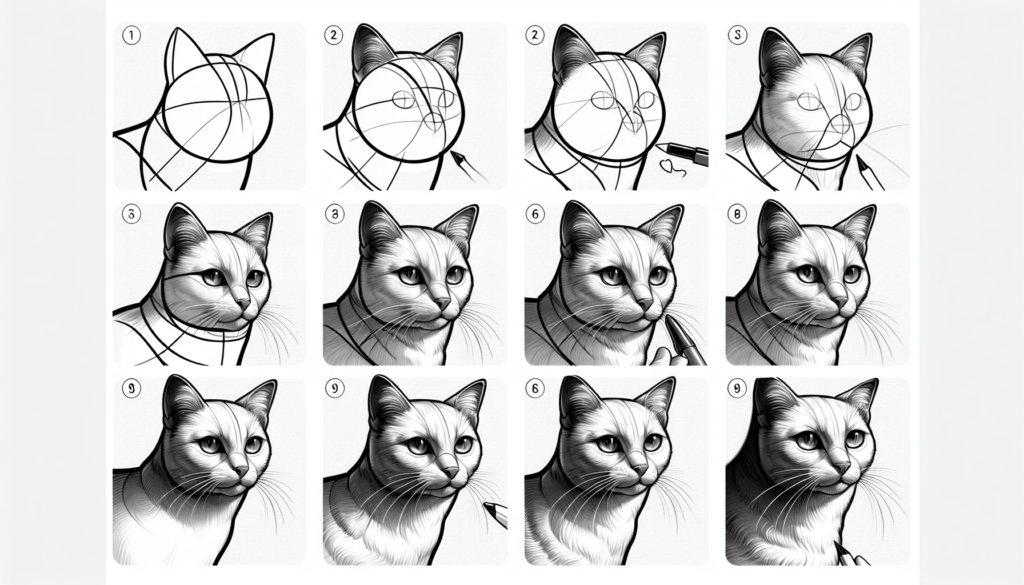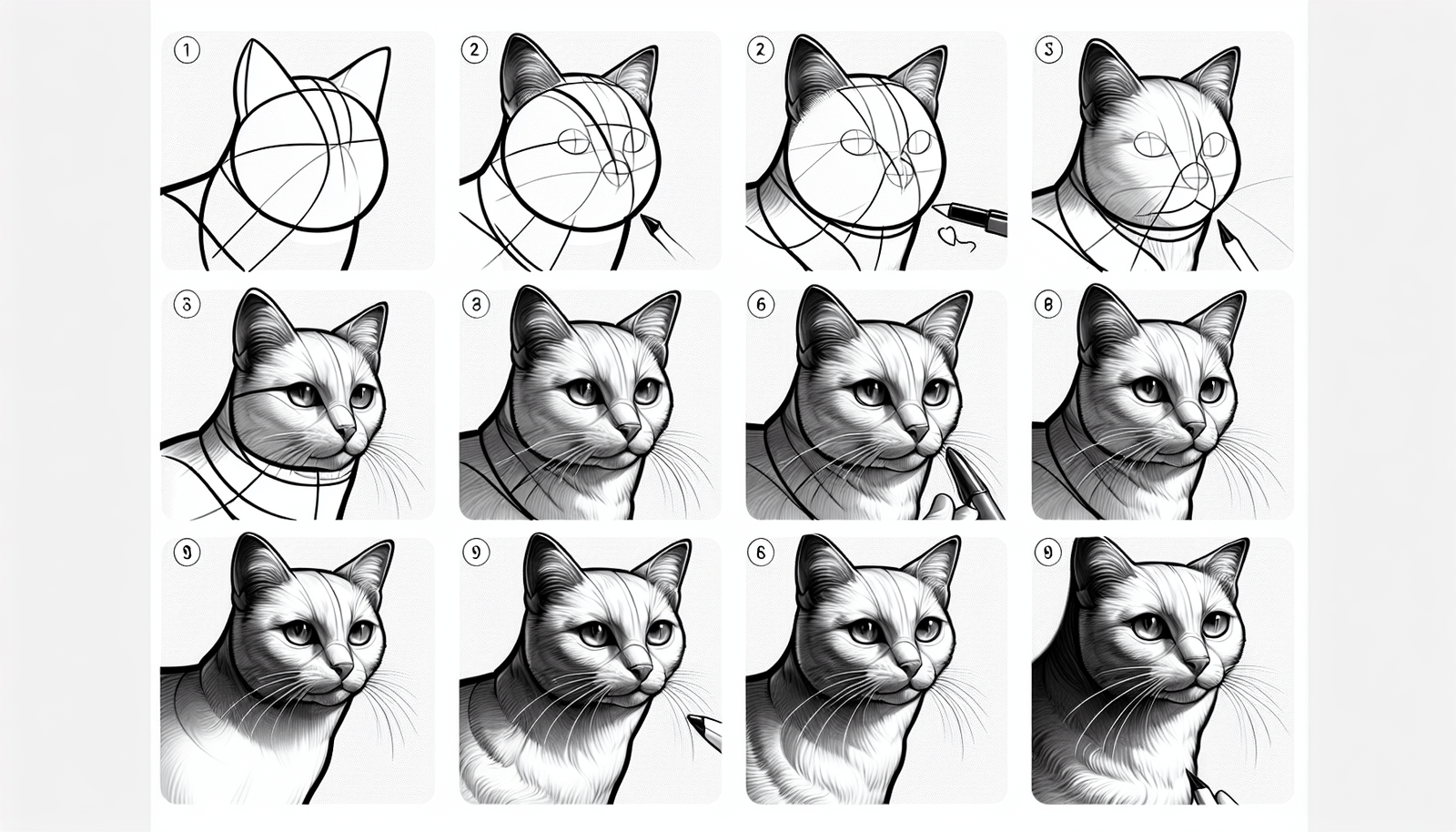Whether you’re an aspiring artist or simply looking to try something new, learning how to draw a cat can be a fun and rewarding experience. From the elegant curves of their bodies to the mesmerizing intricacies of their whiskers, cats offer endless possibilities for artistic expression. In this article, we will guide you through a step-by-step process that will help you create a unique and lifelike representation of a cat. So grab your pencils and let’s get started on this creative journey together.
Understanding Cat’s Anatomy
When it comes to drawing a cat, it’s important to have a solid understanding of its anatomy. One of the best ways to do this is by observing a real cat in person. Take the time to study how the cat moves, how its body is structured, and the proportions of its different body parts. This will help you create a more accurate and realistic representation of a cat in your drawing. Additionally, you can further enhance your knowledge by studying references and books dedicated to feline anatomy. These resources can provide invaluable insights into the unique features of a cat and how they differ from other animals.
Preparing Your Materials
Before you start drawing, it’s essential to gather the right art supplies. Choosing the correct materials will not only make your drawing process smoother but also ensure the best results. Start by selecting art supplies that are suitable for your chosen medium, whether it be pencil, pen, or colored markers. Consider the level of detail you want to achieve and choose the appropriate tools accordingly. Additionally, make sure to have a drawing surface that provides enough space for your artwork. This can be a sketchbook, a canvas, or any other preferred surface. Lastly, determine a suitable position to draw in where you can work comfortably for an extended period of time.

Creating a Base Outline
To begin drawing your cat, it’s helpful to start with a base outline. This will act as the foundation for the rest of your drawing. Start by sketching in basic geometric shapes that represent the cat’s body. These shapes can include circles, ovals, and triangles. Use these shapes to block out the general proportions and structure of the cat. Next, focus on drawing the outline of the cat’s head, taking note of its shape and size in relation to the body. Then, add the outlines of the cat’s ears, tail, and legs to further define its form.
Adding Details to Your Cat
Once you have the base outline in place, it’s time to add more details to your cat. Begin by drawing the cat’s eyes, paying attention to their shape and placement on the head. Cats have unique eyes that can vary in size and shape depending on the breed or the expression you want to depict. Next, capture the cat’s nose and mouth, carefully observing their proportions and angles. To emphasize the cat’s facial features, make sure to include the whiskers. These long, sensitive hairs play a significant role in a cat’s sensory perception. Finally, sketch in the fur, focusing on its texture and flow. Take your time to carefully observe how the fur moves and use light, flowing strokes to represent its softness.

Working on the Cat’s Facial Features
Now it’s time to dedicate some attention to the cat’s facial features. Start by drawing the eyes with finesse and precision. Cats‘ eyes have various distinct characteristics, such as slanted pupils and vibrant colors, so be sure to capture these details accurately. Next, add in the nose and mouth, keeping in mind the unique shapes and structures of a cat’s facial anatomy. Once you have the basic features in place, move on to filling in the ears, paying attention to their size and shape. Finally, complete the cat’s face by drawing the whiskers, as these add an extra level of realism to your drawing.
Drawing Cat’s Fur
Drawing a cat’s fur can be a challenging yet rewarding part of the process. To create a lifelike representation, it’s crucial to understand the texture and pattern of the fur. Observe the cat’s fur closely and determine whether it has a smooth or rough texture. Cats‘ fur can differ greatly depending on their breed and individual characteristics. Use light, feathery strokes to capture the softness of the fur, paying attention to the direction in which it naturally flows. To add depth and dimension, highlight areas of shadow and lighting. Experiment with different techniques to create the illusion of white fur or black fur, using shading and highlighting to achieve the desired effect.
Creating Expressions
Adding expressions to your cat drawing can bring it to life and showcase its personality. Start by drawing happy expressions, focusing on the eyes and mouth. Pay attention to the shape and positioning of the eyes, as they can convey a range of emotions. Smiling or gently curving the mouth can create a happy expression. To capture grumpy expressions, narrow the eyes and curve the mouth downward. For surprised expressions, widen the eyes and open the mouth slightly. Lastly, to depict a sleepy expression, draw the eyes partially closed and the mouth relaxed. The key is to observe real cats or references to understand how their facial features change with different expressions.
Finalizing Your Drawing
As you near the completion of your cat drawing, take the time to finalize it with some important finishing touches. First, carefully erase any unnecessary lines and clean up any areas that may be cluttered. This step will help your drawing look more polished and refined. Next, add final shading and details to enhance the depth and realism of your drawing. Consider using cross-hatching or stippling techniques to create shadows and gradients. If desired, add color to your drawing using colored pencils, markers, or other medium of your choice. Finally, dedicate time to finish the details and touches, making sure everything is clean and crisp.
Drawing Different Breeds
Understanding the differences among cat breeds can be valuable when drawing specific types of cats. Each breed has its own unique characteristics and features that set it apart. Take the time to study and learn about different breeds to accurately depict them in your drawings. For example, when drawing a Siamese cat, focus on capturing their distinct color points and sleek body shape. When drawing a Persian cat, emphasize their fluffy coat and distinctive facial structure. Drawing a Maine Coon cat requires paying attention to their large size and tufted ears. Lastly, when drawing a Sphinx cat, focus on their hairless body and wrinkled skin.
Drawing Kittens
Drawing kittens requires some adjustments to accommodate their smaller size and adorable proportions. Reduce the size of the geometric shapes you use in the base outline to reflect the smaller dimensions of a kitten. Pay extra attention to their round and fluffy faces, using softer lines and curves. Their fur tends to be softer and fluffier than adult cats, so be sure to depict this in your drawing. Experiment with different expressions to capture their innocent and playful nature. Additionally, consider drawing different kitten breeds, each with their own unique features and characteristics.
By following these step-by-step instructions and putting in some practice, you’ll be able to draw cats with confidence and accuracy. Remember to observe real cats, study references, and always have fun with your drawing process. With time and patience, you’ll be creating stunning cat drawings that truly capture the beauty and grace of these majestic creatures. Happy drawing!

